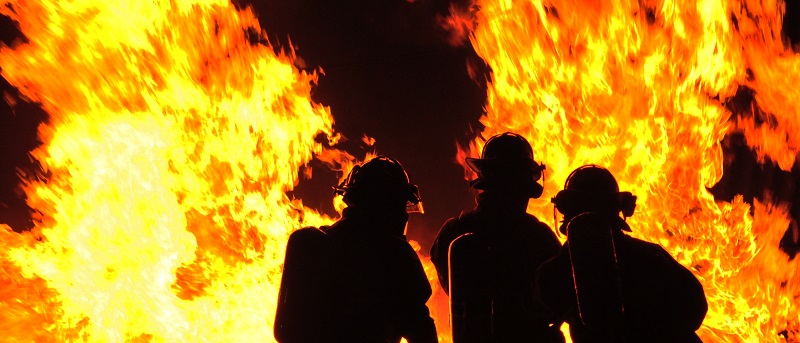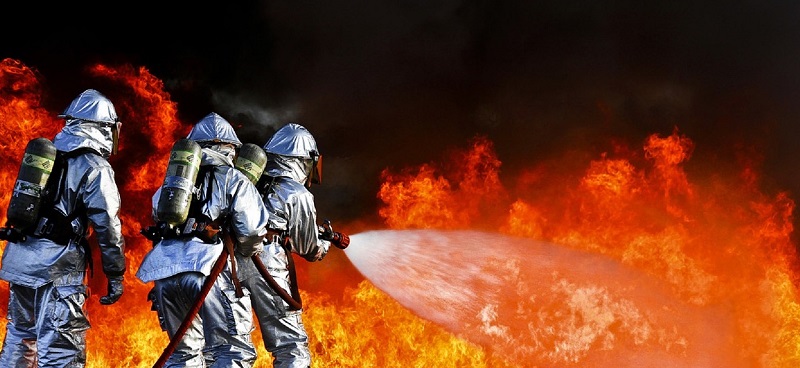
For as long as humans have walked the Earth fire has been a threat to our safety and property, so it seems almost impossible to imagine a world where fire fighters don't exist. Amazingly, organized fire departments didn't come into being until the 18th Century.
Although there is evidence of fire fighting tools in Ancient Egypt, Roman Emperor Augustus is generally credited as the father of organized fire fighting. He formed a group of watchmen to check for and prevent fires in 24 BC. The watchmen would sound an alarm at any sign of fire, their main tool for putting it out: the bucket. Men in the watch would line up from a water source to the site of the fire and pass buckets down the line until the fire was extinguished. These watchmen also employed axes, which were used to make openings in buildings to allow smoke and heat to escape. In the case of a fully-engulfed building, they used hooks and ropes to pull it down before it could spread to nearby structures. This simplistic form of fire fighting was used until the Middle Ages in Rome, Paris and other large European cities.
In 1254, France established the citizen's night watch, which was separate from the King's night watch. The citizen's night watch was in charge of preventing and stopping crimes and fires. After the Hundred Years War in the mid 15th Century, Paris suffered several great fires and in the early 16th Century, the citizen's night watch was disbanded and the prevention of fires and crimes was left to the King's night watch alone.
After years of fires in Boston, governor John Winthrop created the first fire regulations in the U.S which outlawed wooden chimneys and hatched roofs in 1631. In 1648, New Amsterdam (now New York City) enlisted the help of citizens to deal with their fire problems. The “Rattle Watch” was made up of men who volunteered to patrol the streets carrying wooden rattles they would spin when a fire broke out. These rattles are considered to be the first fire alarm. In addition to the Rattle Watch, four men were appointed as fire wardens.
London suffered massive fires in 798, 982, 989 and 1212. But, in 1666, the Great Fire of London destroyed approximately two square miles of the city. The fire left tens of thousands of people homeless and possibly killed dozens (records of the death toll were largely under reported because it was mostly lower class citizens who were killed). After the Great Fire, insurance companies formed private fire brigades to protect their clients' property. These fire brigades only fought fires at properties that were insured, which obviously caused many problems.
The first fire hose was developed by Dutch artist Jan Van der Heyden in 1672. It was made of flexible leather and brass fittings. Shortly after, in 1678, the first fire engine company began in Boston. Then in London in 1690, John Lofting invented the first fire engine, called the “Sucking Worm Engine.” The addition of these technologies helped citizens fight fires quicker and more effectively. In 1725, Richard Newsham created a similar fire engine for the U.S market.
In 1716, the first official fire brigade was formed in Paris. Not long after, the French word pompier, meaning “fire fighter” appeared (its direct translation is “pumper”). Because many people couldn't afford the fee for the brigade's efforts, they often waited to call until the fire was out of control. In response to this, the French government made fire fighting a free service in 1733.
The first fire fighting organization was co-founded by Benjamin Franklin in 1736. The Union Fire Company was a volunteer fire department and the first of its kind in Philadelphia. George Washington was also a volunteer fire fighter at the Friendship Veterans Fire Engine Company in Virginia in the mid 1700s. In 1774, he bought a new fire engine and donated it to the town of Alexandria.
The invention of the fire hydrant is a point of some uncertainty. Generally, credit is given to Frederick Graff, Sr. who was the chief engineer of the Philadelphia Water Works around 1801. The first pillar-style hydrant had a combination hose/faucet outlet and a valve at the top. Graff supposedly held the first patent for the fire hydrant, but this cannot be verified because, ironically, the Washington, D.C patent office was destroyed by fire in 1836, ruining any records.

The first known female fire fighter joined the Oceanus Engine Company in New York in the 1810s. Molly Williams was an African American woman whose service with the department was especially noted during the blizzard of 1818. After many of the male fire fighters were struck down by influenza, Williams helped drag the pumper through deep snow and high winds to fires during one of the biggest storms of the 19th Century.
In 1824, the first organized municipal fire brigade was formed in Scotland. The Edinburgh Fire Engine Establishment also created a set of modern standards for fire department operation that later influenced the formation of the London Fire Engine Establishment in 1832. The first professional fire department with 100% paid employees was founded in 1853 in Cincinnatti, Ohio.
By the middle of the 19th Century, old fire fighting tools were becoming obsolete as populations grew and there was more demand for fire fighters. Although it had been invented in 1829, the horse-drawn steam engine wasn't formally used as a structural fire fighting tool until 1860.
After the American Civil War ended in 1865, the U.S established the first government-run fire departments. This helped regulate departments and their volunteers and employees. As fire fighting became more sophisticated, so did the tools of the trade. In 1907, the first internal combustion fire engine appeared in the U.S. By 1925, steam engines were totally obsolete and disappeared entirely.
During the 20th Century, many advances were made that helped fire fighters and the public respond to fires sooner. Winnipeg, Manitoba was the first North American city to use a central emergency number in 1959. By the 1980s, nearly 97% of all North American cities were connected to 9-1-1. Fire alarms, sprinkler systems and smoke detectors became commonplace in homes by the 1970s.
Today, fire fighters are a mix of paid, paid on-call and volunteer, but many areas still have fully-volunteer departments. It is clear that fire fighting is a brave and selfless profession with many challenges. Thanks to technology, though, fighting fires is becoming safer and more streamlined. There's no way to predict what fire fighters of the future will look like, but we can be sure that they will continue to be heroic in the face of danger.
